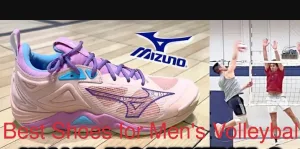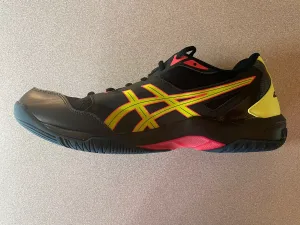The best shoes for men’s volleyball are not necessarily the fancy and good-looking ones like sneakers and so on. In fact, not all shoes are fit for volleyball because volleyball on its own is a sport that demands agility, quick reflexes, and explosive movements.
For men who take the game seriously, choosing the right volleyball shoes can make all the difference. In volleyball shoes, both traction, cushioning, and fit matter because your footwear will definitely affect your performance, comfort, and even injury prevention.
This comprehensive article guide will help you choose the best shoes for men’s volleyball based on your playing style, position, and personal needs.
Why Are Volleyball Shoes Important in Men’s Volleyball?
Many people wonder if regular sneakers or running shoes are fit for volleyball. The answer is a NO. Volleyball shoes are uniquely designed to meet the needs of the volleyball sport. Volleyball demands frequent lateral movements, jumping, and quick changes in direction.
In fact, using improper footwear in men’s volleyball or in any kind of volleyball game increases the risk of slipping, ankle sprains, discomfort, and injuries.
See Also: What Makes Volleyball Shoes Different? Top 6 Key Features
Key Features of Men’s Volleyball Shoes
What makes men’s volleyball shoes unique is not the outward appearance but the inward quality and technology. Below are key features of men’s volleyball shoes:
- Grip and Traction: Ensures stability during quick lateral moves.
- Cushioning: Reduces impact on joints during jumps.
- Durability: Built to handle the friction from indoor courts.
- Lightweight Design: Supports faster movements without fatigue.
Top Men’s Volleyball Shoe Qualities to Look For
Choosing the perfect volleyball shoe depends on understanding the key features and how they align with your needs.
1. Sole Material and Grip
Volleyball courts are usually hardwood or synthetic, making grip critical. Look for gum rubber soles that offer excellent traction without leaving marks.
Why It Matters: Slipping mid-play can lead to missed points or injuries. Shoes with proper grip provide better control on the court.
2. Cushioning and Shock Absorption
Jumping is a constant in volleyball. High-quality cushioning, such as GEL technology in Asics or Zoom Air in Nike, helps reduce the impact on your knees and ankles.
| Brand | Cushioning Technology | Benefits |
| Asics | GEL Cushioning | Reduces impact on landings. |
| Mizuno | Wave Technology | Distributes pressure evenly. |
| Nike | Zoom Air | Responsive cushioning for jumps. |
3. Ankle Support
Ankle sprains are common in volleyball, especially during blocking or spiking. Shoes with higher ankle collars or better lateral support can reduce the risk of injury.
Pro Tip: If you’re prone to sprains, consider wearing ankle braces alongside supportive shoes.
Best Shoes for Men’s Volleyball in 2025

Below is a roundup of some of the best men’s volleyball shoes in 2025, categorized by their standout features and qualities.
-
Best Overall: Asics Gel-Rocket 12

Why It Stands Out:
- Affordable yet packed with features.
- Excellent traction and comfort.
Suitable for: beginners and intermediate players.
-
Best for Jumping: Mizuno Wave Momentum 2

Why It Stands Out:
- Incredible stability for high jumpers.
- Wave technology for shock absorption.
Suitable For: Middle blockers and outside hitters.
-
Best Lightweight Option: Adidas Crazyflight X

Why It Stands Out:
- Lightweight design perfect for agility.
- EVA midsole for responsive cushioning.
Suitable For: Setters and liberos.
See Also: 5 Best Budget Volleyball Shoes
| Shoe Name | Key Feature | Price Range | Ideal Position |
| Asics Gel-Rocket 12 | All-rounder | $60-$80 | Beginners, Intermediate |
| Mizuno Wave Momentum 2 | Jumping stability | $110-$140 | Middle blockers |
| Adidas Crazyflight X | Lightweight agility | $100-$120 | Setters, Liberos |
The table below presents a summary of the top best volleyball shoes for men, for different needs and positions:
| Shoe Model | Best For | Key Features | Price Range |
| ASICS GEL-Rocket 11 | Budget-Friendly Choice | Lightweight, GEL cushioning, excellent traction | $60–$80 |
| Mizuno Wave Lightning Z7 | All-Round Performance | Wave technology, responsive cushioning, stability | $110–$130 |
| Nike Zoom HyperAce 2 | Power Hitters | Durable, strong lateral support, Zoom Air cushioning | $120–$150 |
| Adidas Stabil Next Gen | Aggressive Defenders | Non-marking sole, sock-like fit, abrasion-resistant | $100–$120 |
| Under Armour Block City | High Jumpers | Lightweight, shock-absorbing, breathable upper | $80–$100 |
How to Choose the Right Volleyball Shoes for Your Position
- For Setters
Setters need to be quick on their feet, moving laterally to set the ball. Choose shoes that are lightweight and offer excellent grip.
Top Pick: Adidas Crazyflight X.
- For Spikers
Spikers require strong cushioning to absorb impact from frequent jumping. Shoes with extra ankle support are also beneficial.
Top Pick: Mizuno Wave Lightning Z7.
- For Liberos
Liberos are defensive specialists who require agility for digging and receiving. Opt for lightweight shoes with great traction.
Top Pick: Nike React Hyperset.
See Also: Libero in Volleyball Explained
- For All-round Players
If you play multiple positions, look for versatile shoes that balance cushioning, grip, and support.
Top Pick: Asics Gel-Tactic 9.
How to Maintain Your Volleyball Shoes to Last Long?
Good volleyball shoes are an investment, so it’s essential to take care of them by maintaining them properly. Below are a few tips to maintain your volleyball shoes if you want them to last longer:
- Use Indoors Only: Avoid wearing them outside to preserve the sole’s grip.
- Clean Regularly: Wipe down with a damp cloth to remove dust and dirt.
- Rotate Shoes: If you play often, having two pairs can extend their lifespan.
- Replace When Worn Out: If the sole loses traction or cushioning feels flat, it’s time for a new pair.
Read more: How Long do Volleyball Shoes Last
FAQs
Can I Use Running Shoes for Volleyball?
No. Using running shoes for volleyball is not recommendable because running shoes lack the lateral support and grip needed for volleyball. They’re designed for forward motion, not the multidirectional movements in volleyball.
How Often Should I Replace Volleyball Shoes?
If you play 3-4 times a week, replace them every 6-12 months. Casual players may get 1-2 years of use. So the frequency will depend on your usage. It is recommended to have 2 to 5 shoes so you can use them interchangeably.
Are Expensive Volleyball Shoes Worth It?
Higher-priced shoes often have advanced features like better cushioning and durability. However, mid-range options like the Asics Gel-Rocket are excellent for most players.
Do I Need Ankle Braces with Volleyball Shoes?
If you’ve had prior ankle injuries, braces are a good idea. They provide extra support that even high-quality shoes might not fully offer.
Read more: Best Volleyball Shoes 2025: Review of the Best Models




